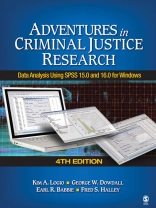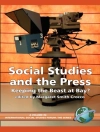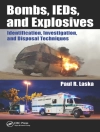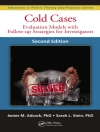The only book of its kind, this text guides students through the process of conducting criminological data analysis. Used primarily in lab settings, the Fourth Edition of Adventures in Criminal Justice Research, derived from the popular Adventures in Social Research (Babbie et al, Pine Forge Press/SAGE), systematically takes students through a series of investigative adventures. More than 150 screenshots in the text offer clear visual step-by-step instructions to solidify student understanding.
New to This Edition
- Incorporates even more criminal justice exercises, policy-related exercises, and hot criminal justice–related issues throughout the book
- Includes analysis of criminal justice and other social issues using data from GSS sets, the 2000 Census, the Harvard School of Public Health College Alcohol Survey, and other data sets available to the public through the Internet
- Offers increased coverage of Web-based surveys and survey software
Accompanied by High-Quality Ancillaries!
- A new Student study site a features numerous data sets along with online appendices – Appendix A: Sample Journal Article and ’How to Read a Research Article’, Appendix B: College Alcohol Study Questionnaire, and Appendix C: Chapter Review Quizzes with Answers.
Intended Audience
This practical textbook is a valuable supplement for courses in Research Methods and/or Statistics in departments of criminal justice or criminology. The only book of its kind, this text guides students through the process of conducting criminological data analysis. Used primarily in lab settings, the of , derived from the popular (Babbie et al, Pine Forge Press/SAGE), systematically takes students through a series of investigative adventures.
Innehållsförteckning
About the Authors
Preface for Instructors
Part I: Preparing for Criminal Justice Research
Chapter 1: Theory, Measurement, and Research Development
1.1 Research in Criminal Justice
1.2 Theory in Criminal Justice: Routine Activity Theory
1.3 Hypotheses in Criminal Justice Research
1.4 Should Abortion Be Legal?
1.5 Crime, Punishment, and Violence
1.6 The Logic of Measurement
1.7 Validity Problems
1.8 Reliability Problems
1.9 Multiple Indicators
1.10 Level of Measurement
1.11 Units of Analysis
1.12 Summary
Chapter 2: Criminal Justice Data Sets
2.1 Primary and Secondary Data Analysis
2.2 Description of a Data Set: The General Social Survey
2.3 Sampling: How Representative Are Your Data?
2.4 Data Collection
2.5 General Social Survey Variables
2.6 Harvard School of Public Health College Alcohol Study
2.7 Other Criminal Justice Data Sets Available on the Web
2.8 Downloading Data from the Internet
2.9 Your Own Criminal Justice Survey
2.10 Summary
Chapter 3: Using SPSS
3.1 Using SPSS to Open Existing Data Sets
3.2 Learning More: The Windows Tutorial
3.3 Creating Your Own Data Set
3.4 Coding Your Data
3.5 Entering Your Data
3.6 Using Published Criminal Justice Data
3.7 Summary
Part II: Univariate Analysis
Chapter 4: Describing a Variable
4.1 A Graphic View
4.2 Measuring Central Tendency and Dispersion
4.3 Modifying Variables With Recode
4.4 Practicing Recodes
4.5 Saving Your Work
4.6 Summary
Chapter 5: Working With Variables
5.1 Political Views: Liberalism Versus Conservatism
5.2 Political Policy Affiliation
5.3 Gun Laws and Capital Punishment
5.4 Understanding Binge Drinking
5.5 Other Survey Items About Crime and Justice
5.6 Crime and Justice Data for the American States
5.7 Summary
Chapter 6: Creating Composite Measures
6.1 Using Crosstabs
6.2 Combining Two Items in an Index
6.3 Checking to See How the Index Works
6.4 Creating a More Complex Index With Count
6.5 Creating the FBI Crime Index
6.6 ’Secondhand Binge Effects’: Creating an Index
6.7 Summary
Part III: Bivariate Analysis
Chapter 7: Investigating the Correlates of Binge Drinking and Attitudes Toward Gun Control and Capital Punishment: Independent Versus Dependent Variables
7.1 Moving Beyond Description: Comparing Two Variables
7.2 Comparing Binge Drinking and Gender
7.3 Examining Binge Drinking and Race
7.4 Continuing the Analysis: Binge Drinking and Religiosity
7.5 The Impact of the Minimum Purchase Law: Bingeing and Age
7.6 Political Orientation, Guns, and Capital Punishment: Independent Versus Dependent Variables
7.7 The Relationship Between POLVIEWS and PARTYID
7.8 Age and Politics
7.9 Religion and Politics
7.10 Gender and Politics
7.11 Race, Class, and Politics
7.12 Education and Politics
7.13 Martial Status and Politics
7.14 Gun Laws and Capital Punishment
7.15 Summary
Chapter 8: Measures of Association
8.1 Lambda
8.2 Gamma
8.3 Pearson′s r, the Correlation Coefficient
8.4 Regression
8.5 Summary
Chapter 9: The Existence, Strength, and Direction of an Association
9.1 Chi-Square
9.2 t-Tests
9.3 Analysis of Variance
9.4 Summary
Part IV: Multivariate Analysis
Chapter 10: Examining Several Independent Variables
10.1 Age, Sex, and Religiosity
10.2 Family Status and Religiosity
10.3 Social Class and Religiosity
10.4 Other Variables to Explore
10.5 Multiple Linear Regression
10.6 Summary
Chapter 11: Exploring What Shapes Attitudes About Guns and Capital Punishment
11.1 Political Philosophy and Party Identification
11.2 The Mystery of Politics and Marital Status
11.3 Guns and Capital Punishment
11.4 Summary
Chapter 12: Logistic Regression: Understanding College Student Drug and Alcohol Abuse
12.1 Binge Drinking: A Dichotomous Dependent Variable
12.2 The Odds Ratio: Gender and Binge Drinking
12.3 Using SPSS for Windows Student Version for the Odds Ratio
12.4 Logistic Regression in SPSS for Windows
12.5 Multiple Logistic Regression
12.6 Summary
Appendix A: How to Read a Research Article
Appendix B: College Alcohol Study Questionnaire (on the Student Study Site)
Appendix C: Chapter Review Quizzes and Independent Projects (on the Student Study Site)
Appendix D: Answers to Chapter Review Quizzes (on the Student Study Site)
References and Suggested Readings
Glossary/Index
Om författaren
Fred Halley, Associate Professor Emeritus, SUNY-Brockport, received his bachelor’s degree in sociology and philosophy from Ashland College and his master’s and doctorate degrees from Case Western Reserve University and the University of Missouri, respectively. Since 1970, he has worked to bring both instructional and research computer applications into the undergraduate sociology curriculum. Halley has been recognized for his leadership in the instructional computing sections of the Eastern and Midwest Sociological Societies and the American Sociological Association. At Brockport, he served as a collegewide social science computing consultant and directed Brockport’s Institute for Social Science Research and the College’s Data Analysis Laboratory. Off campus, Halley directed and consulted on diverse community research projects that were used to establish urban magnet schools, evaluate a Head Start family service center, locate an expressway, and design a public transportation system for a rural county. Now residing in Rochester, New York, he plays an active role in a faith-based mentoring program for ex-offenders, and he volunteers for Micrecycle, an organization that refurbishes computers used by those on the other side of the computer divide in schools, daycares, youth centers, and other community organizations.












